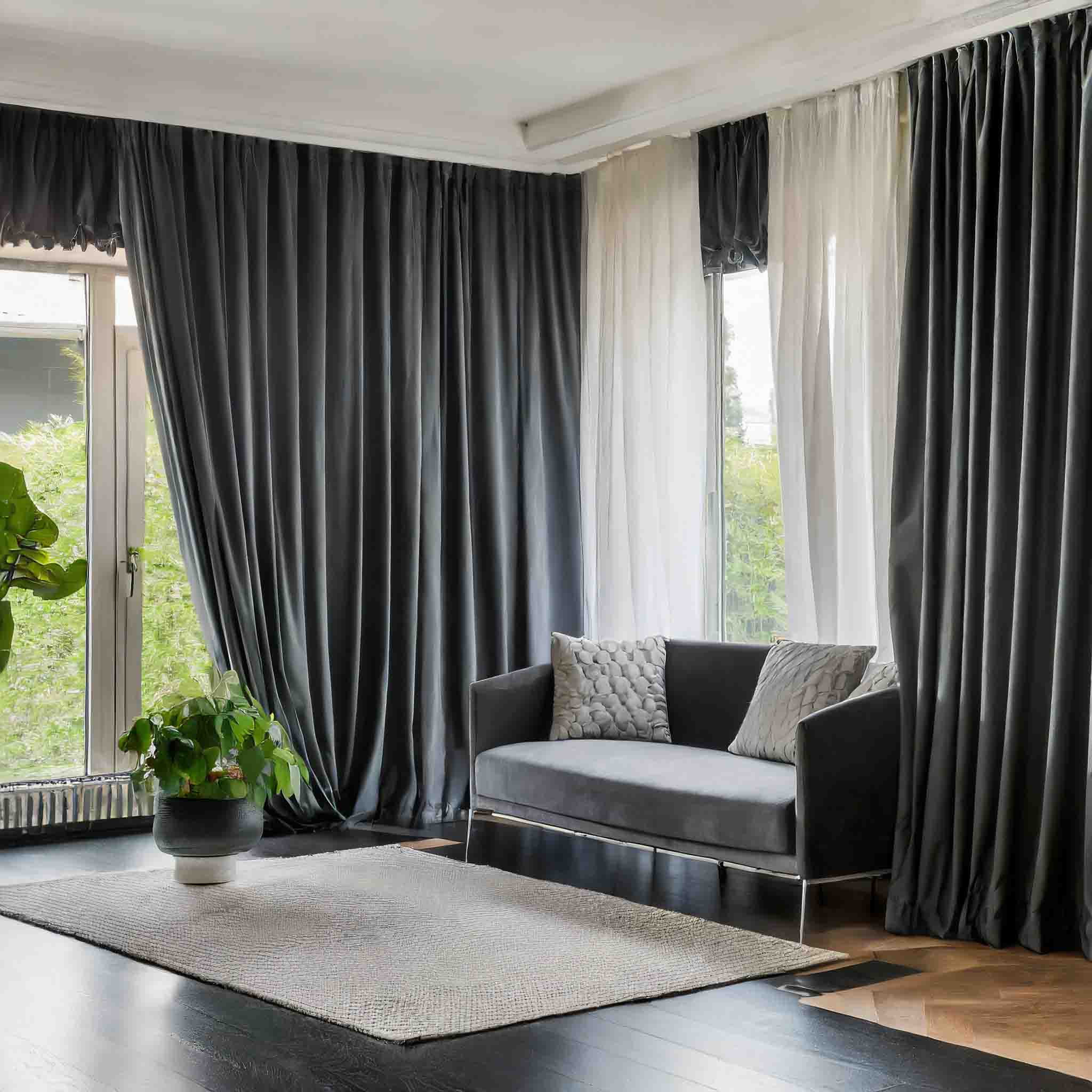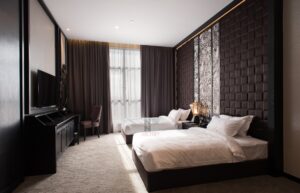Understanding Acoustic Curtains
Acoustic curtains, often referred to as soundproof curtains, are specialized window treatments designed to reduce noise levels and enhance sound quality within a room. Unlike regular curtains that primarily serve aesthetic purposes, acoustic curtains are engineered to absorb and dampen sound waves, thereby minimizing noise transmission. These curtains typically consist of multiple layers of dense materials, such as heavyweight fabrics, foam, and soundproofing membranes, which work together to block and absorb sound. By utilising advanced materials and construction techniques, acoustic curtains offer superior noise reduction capabilities compared to traditional window coverings.
The Science Behind Acoustic Curtains
The effectiveness of acoustic curtains lies in their ability to manipulate sound waves through absorption and reflection mechanisms. When sound waves strike the surface of the curtain, the materials within the curtain absorb a portion of the sound energy, converting it into heat. This absorption process reduces the amplitude of the sound waves, thereby diminishing the noise level in the room. Additionally, acoustic curtains may also incorporate reflective layers that bounce sound waves away from the room, further enhancing sound control. Various factors, including the thickness and density of the curtain materials, as well as the specific composition of the soundproofing layers, influence the curtain’s ability to absorb and block sound effectively.
Benefits of Using Acoustic Curtains
Acoustic curtains offer a range of benefits beyond noise reduction, making them a versatile solution for improving both acoustic comfort and privacy in various settings. One of the primary advantages of acoustic curtains is their ability to create a quieter and more peaceful environment by reducing external noise pollution. Whether you live in a busy urban area or near a noisy street, acoustic curtains can help create a serene sanctuary within your home. Furthermore, these curtains can significantly enhance speech intelligibility by reducing echo and reverberation, making conversations clearer and more enjoyable. Additionally, acoustic curtains provide an added layer of privacy by blocking sound transmission and preventing outsiders from eavesdropping on confidential conversations.
Applications of Acoustic Curtains
Acoustic curtains find widespread applications in both residential and commercial settings, where noise control and privacy are paramount. In residential environments, these curtains are commonly used in bedrooms, home offices, and entertainment spaces, such as home theaters, to create a more peaceful and immersive atmosphere. In commercial settings, acoustic curtains are deployed in offices, conference rooms, recording studios, and restaurants to optimize acoustics and enhance the overall auditory experience for occupants. Whether you’re seeking to improve productivity in the workplace or create an intimate dining ambiance, acoustic curtains offer a versatile solution for achieving optimal sound management.
Considerations When Choosing Acoustic Curtains
When selecting acoustic curtains for your space, several key factors should be taken into consideration to ensure optimal performance and satisfaction. Firstly, it’s essential to determine the appropriate size and fit of the curtains based on the dimensions of your windows and the desired level of coverage. Properly fitted curtains will maximize their effectiveness in blocking out noise and light. Secondly, consider the aesthetics and design options available, as acoustic curtains come in a variety of colours, patterns, and textures to complement your interior decor. Additionally, evaluate your budgetary constraints and explore the range of options available within your price range. Lastly, consider the installation requirements and whether you prefer to install the curtains yourself or enlist the services of a professional installer for a seamless and hassle-free experience.
Maintenance and Care Tips for Acoustic Curtains
To maintain the performance and longevity of your acoustic curtains, regular cleaning and care are essential. Depending on the fabric and construction of the curtains, they may require different cleaning methods, such as vacuuming, spot cleaning, or dry cleaning. Always refer to the manufacturer’s care instructions for guidance on the appropriate cleaning techniques. Avoid using harsh chemicals or abrasive cleaners that could damage the curtain materials or compromise their acoustic properties. In addition to cleaning, periodically inspect the curtains for any signs of wear or damage, such as tears or loose stitching, and address any issues promptly to prevent further deterioration.
DIY vs. Professional Installation: Which Is Better?
When it comes to installing acoustic curtains, you have the option of either undertaking the installation yourself or hiring a professional installer. While DIY installation may seem like a cost-effective option, it’s important to consider your level of expertise and the complexity of the installation process. Acoustic curtains, particularly those designed for maximum soundproofing, may require precise measurements and specialized mounting hardware to ensure proper fit and performance. Professional installers have the necessary skills, tools, and experience to handle the installation process efficiently and effectively, saving you time and potential headaches. Additionally, professional installation often comes with warranties and guarantees, providing added peace of mind and assurance of quality craftsmanship. Ultimately, weigh the pros and cons of DIY vs. professional installation based on your preferences, budget, and the complexity of the project.
Exploring Innovative Trends in Acoustic Curtains
As technology continues to advance, so do the capabilities and features of acoustic curtains. One emerging trend is the integration of smart technology and automation features into acoustic curtain systems. Smart acoustic curtains can be controlled remotely via smartphone apps or integrated with home automation systems, allowing users to adjust settings such as opening and closing times, sound levels, and ambient lighting. Another trend is the development of sustainable and eco-friendly materials for acoustic curtains, in response to growing consumer demand for environmentally responsible products. Manufacturers are exploring renewable materials, such as recycled fabrics and natural fibres, to reduce the environmental footprint of acoustic curtains while maintaining high performance and durability. These innovative trends represent exciting opportunities for enhancing the functionality, efficiency, and sustainability of acoustic curtain solutions in the future.
Future Outlook: Evolution and Advancements in Acoustic Curtain Technology
Looking ahead, the future of acoustic curtains holds promise for continued innovation and advancement in sound management technology. With ongoing research and development, we can expect to see further improvements in noise reduction capabilities, as well as enhanced integration with smart home systems and IoT (Internet of Things) devices. Additionally, advancements in material science and manufacturing techniques may lead to the development of lighter, more flexible, and environmentally sustainable acoustic curtain solutions. As society places increasing importance on creating healthier and more comfortable indoor environments, acoustic curtains will play a crucial role in achieving these goals by providing effective sound control and privacy solutions for homes, offices, and public spaces alike.




